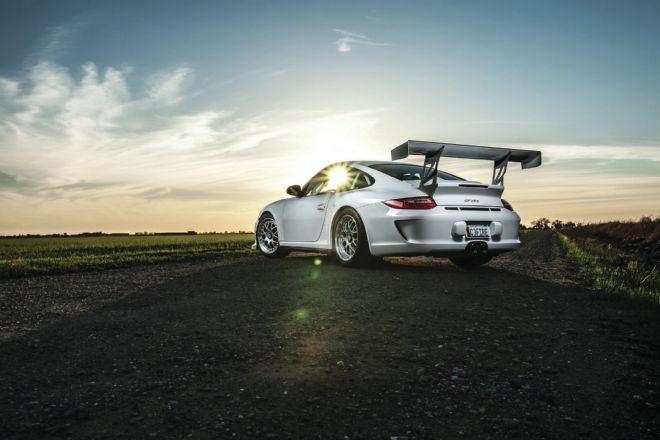If you’ve ever seen a Porsche Supercup race, you’ve probably wondered how you’d fare within the Porsche’s GT3-based spec series. And if you haven’t, then you must have considered what it would be like to drive one of these cars on the street…
If you’ve been lucky enough to drive the 911 GT3 RS, because it’s actually the basis for your GT3 Cup cars employed in the Supercup series, in fact, you can get a fairly good idea of the things a Cup car is much like. The biggest distinction between the Cup car and GT3 RS are the transmissions (sequential to the racecar) and about 400 lb in weight (2646 lb race vs 3020lb road).
I’m sure most of us could be happy with a stock GT3 RS – one of the most focused and least compromising production cars you can get. But some people, like John Mendoza, don’t want to accept second best. They want to know exactly what it would be like to drive a Cup car, so he did something about this…
2011 porsche GT3 RS porsche motorsport OMP steering wheelwhen he loaded his 2007 997.1 GT3 on a trailer bound for Tennessee, signing the title over to the newest owner. As well as in a classic case of not understanding what you’ve got until it’s gone, it didn’t take long for him to start longing for one more one.
He went a step further, though, and put his name listed at his local Porsche dealership for the yet-to-be-unveiled 991 GT3. But when he discovered the new car would only be available with Porsche’s dual-clutch PDK transmission, he cancelled his order, preferring the connection and control of a manual shift more than the automated one.
Back searching, he started looking for a 997.2 GT3 RS, eventually finding the right example in Florida. It was in Carrera white with red decals along withThen he added a Cup front splitter, which extends 15mm lower than the stock part to increase downforce. After that, he swapped the reclining carbon fiber seats, which weigh 39 lb each, for a pair of European-spec GT3 Clubsport seats (similar to fitted from the Carrera GT). Apparently, they cost a mind-blowing $20k, or what we call a payment in advance on a house!
The next swap was in the stock rear spoiler to the Cup wing. It sits considerably higher, measuring 66.9 towards the road car’s 57.5. It certainly makes a statement and the splitter and wing came directly from Porsche Motorsport, costing about $5300.
Several weeks later, he got his hands on a titanium Akrapovic Cup exhaust from Aleks Doba at Alekshop in Fremont, CA. The $7k system was great for an extra 8hp at and 3970rpmmainly because it does away with the OEM side mufflers, weighed 46.3 lb less than the stock – further increasing the performance.Shaving weight was important because he’d then add with the FIA-approved, European Club Sport, six-point rollcage from Carnewal in Belgium. The increased rigidity and safety was Mendoza’s main concern together with his intention to make use of the finished car in the track, though installed by Mike Tolle at Tolle Fab in Rancho Cordova, CA, the $10k cage would add 84 lb.
The next thing was swapping the stock steering wheel for the lighter OMP part from Porsche Motorsport, attached to a Works Bell short hub and Rapfix II quick release.
Then came a CAE shifter from Germany. At first glance it appears like a sequential shifter but actually retains the H-pattern of the stock transmission. The lever is taller, placed even closer to the controls for quicker access and Mendoza said the action was similar to aare crucial to any project build and John managed to purchase the same BBS Motorsport wheels as used on the GT3 Cup car. They assist shed some unsprung weight, tipping the scales at 22.2/23.4 lb front/rear versus 23.5/28 lb for the stock rims.
The wheels were purchased through our friend Eric Nareshni at Supreme Power Parts in Placentia, CA, costing about $1600 per corner. He also provided the tires, which are 245/40 and 335/30 Michelin PPS2 on the street. The car runs a second group of 18s in the track, fitted with 245/40 and 305/35 Nitto NT01 rubber.
To date, the suspension remains stock, the GT3 RS setup stiff enough for its intended use, although John intends to upgrade to RSS control arms in the future.The 450hp 3.8-liter RS motor didn’t have much headroom for improvement but John took it to Sharkwerks in Fremont, CA nonetheless, as a production engine using one of the highest horsepower-per-liter figures on earth. They fitted the EVOMSit software that had been reportedly good for another 16whp and 13 lb-ft on 91-octane gas with all the stock exhaust. Throw in the Akrapovic system and the engine should be great for an extra 25-30hp to the crank.
Mendoza revisited his range of seats, determining to remove the pricey Carrera GT items to opt for ultra-lightweight Recaro Pro Racer seats, like a final flourish. Manufactured in carbon/kevlar and provided by Griffin Motorwerke, they weigh a scant 10 lb each, counteracting the inclusion of the rollcage.
Some $43k later, John presently has a faster, more and stiffer stable 911 GT3 RS, highlighted with genuine Cup parts and a selection of topnotch components. While that’s huge budget, he could claim that he now knows what it’s like to drive a GT3 Cup car on the road.

